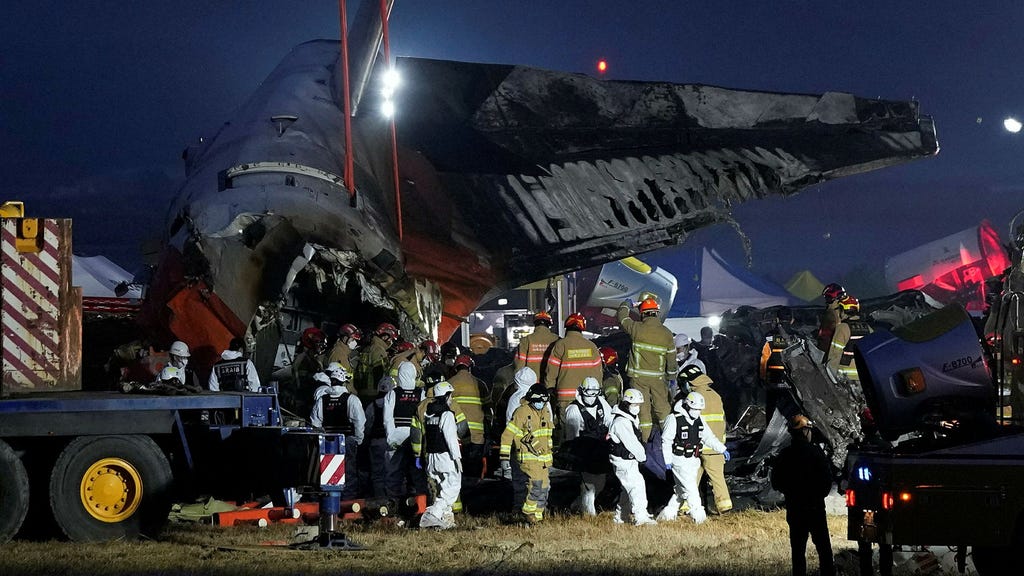Tragedy in South Korea: A Nation Grieves After Devastating Plane Crash
A devastating plane crash at Muan International Airport in South Korea on Sunday claimed the lives of 179 people, leaving only two survivors. The ill-fated Boeing 737-800 aircraft, operated by Asiana Airlines, was en route from Seoul’s Gimpo Airport when it encountered landing gear problems and ultimately crashed into a concrete wall upon landing. This horrific incident sent shockwaves through the nation and prompted immediate calls for a comprehensive investigation into the country’s aviation safety protocols. The tragedy was further compounded by a near-miss incident just a day later, when another Boeing 737-800, operated by Jeju Air, experienced landing gear issues shortly after takeoff from Gimpo Airport. While the Jeju Air flight landed safely, the incident underscored the urgency and importance of addressing potential systemic safety concerns.
In the aftermath of the Muan crash, South Korea’s acting president, Choi Sang-Mok, expressed his deep sorrow and pledged swift action. He immediately ordered an emergency safety inspection of the entire aviation system, aiming to identify any vulnerabilities and prevent future tragedies. This inspection will encompass all aspects of airline operations, including maintenance procedures, pilot training, and air traffic control protocols. Recognizing the significant number of Boeing 737-800 aircraft in operation within South Korea, authorities are also considering a targeted inspection of all 101 planes of this model currently utilized by South Korean airlines. Jeju Air, which operates 39 Boeing 737-800s out of its fleet of 41 aircraft, will be a key focus of this investigation. Beyond the technical aspects, President Choi emphasized the critical importance of providing support to the victims’ families and caring for the two survivors, highlighting the human toll of this devastating event.
As investigators sifted through the wreckage at Muan, details began to emerge about the final moments of the doomed flight. Pilots had reported a bird strike shortly after receiving a warning from the control tower about birds in the vicinity. This prompted the pilots to attempt a second landing approach, which tragically ended in the plane’s belly landing, subsequent crash into the concrete wall, and the ensuing fire. The presence of this concrete wall at the end of the runway has raised questions among aviation safety experts, who have expressed concerns about its potential contribution to the severity of the crash. According to experts like Christian Beckert, a Lufthansa pilot and aviation safety specialist, the placement of such a structure at the end of a runway is unusual and potentially hazardous.
The recovery of the flight recorder, albeit damaged, offers a glimmer of hope for understanding the precise sequence of events leading to the crash. However, the extent of the damage raises concerns about the retrievability of the data. Under international regulations, South Korea will lead the investigation, collaborating with authorities in the United States, where the aircraft was manufactured. Boeing, the aircraft manufacturer, will also participate in the investigation, providing technical expertise and insights into the aircraft’s design and performance. This collaborative effort aims to leave no stone unturned in the pursuit of answers and accountability.
The crash at Muan International Airport serves as a stark reminder of the inherent risks associated with air travel and underscores the crucial importance of rigorous safety protocols. The loss of 179 lives represents an immeasurable tragedy for the families and communities affected. The ongoing investigation will play a vital role in understanding the contributing factors to this disaster and implementing measures to prevent similar tragedies in the future. The focus will remain on enhancing aviation safety, supporting the grieving families, and honoring the memory of those who perished in this heartbreaking event.
As the investigation unfolds and more information comes to light, the aviation industry worldwide will be watching closely. The findings of this investigation could have far-reaching implications for aviation safety procedures and regulations, potentially leading to changes in aircraft design, pilot training protocols, and airport infrastructure. The ultimate goal is to create a safer and more secure environment for air travel, minimizing the risks and preventing future occurrences of such devastating accidents. The lessons learned from this tragedy will undoubtedly shape the future of aviation safety, ensuring that the lives lost are not in vain.














